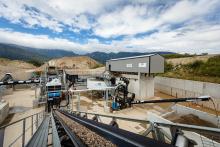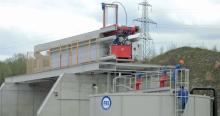
High cost of landfilling and difficulty gaining permission for new quarries means that soil washing can provide vital resources to the construction market. Claire Symes visited two sites in Switzerland to find out more
On the outskirts of Zurich is an industrial unit that has been transforming contaminated granular material into prime aggregates for the last 15 years. The blue clad building is not a warehouse but is home to what was one of the worlds first soil washing facilities when it opened in 1992.
Current legislation in Switzerland restricts landfilling unless no other treatment or recycling is possible and in Zurich businesses must recycle a minimum percentage of waste. Strict regulation has led to adoption of soil washing techniques and Swiss-based Eberhard was one of the first companies to operate a plant commercially.
According to Eberhard's owner Heinrich Eberhard, soil contaminated by industrial activities such as chemical plants, gasworks and steel mill, present a long lasting threat to ecology and human health. "Most types of soils soak up comtanimants like a sponge," he said. "The presence of these pollutants needs to be dealt with before site development. Soil washing allows the material to be excavated from site, clearing the way for construction, and then decontaminated for reuse.
"Unlike thermal processes and bioremediation, soil washing can treat materials contaminated with heavy metals as well as both organic and inorganic compounds." Eberhard's ESAR plant takes waste material by truck and train from Zurich and the surrounding area and washes it clean of contaminants ready for reuse in Eberhard's nearby concrete plant. Today the ESAR plant processes up to 100tonnes of material an hour, with around 200,000tonnes passing through the site annually.
The site has storage for up to 50,000tonnes of material - two thirds of it is for the incoming contaminated material and the other third is for cleaned and graded aggregates. "On receiving material, we weigh it and separate it according to the contaminants," said Eberhard. "All incoming material is tested before it is processed to make sure we know exactly what we're dealing with." The soil washing process is similar to mineral processing of virgin aggregates in quarries. The method takes advantage of the way contaminants are generally preferentially absorbed by humic matter and clay compounds. Eberhard uses the washing process to remove these particles from the bulk material and separate out the sand and gravel fractions.
The processing sequentially separates the gravel and sand using screening and cycloning, and then treats the processing water to remove pollutants.
First the material is screened and any oversized particles are passed through an impact crusher. From there, the material passes through two log washers, which use gravity separation to remove foreign matter and separate the clean gravel, which is screened to separate it by size.
The sand slurry is then taken for further treatment and passed through spiral concentrators, which remove the silt, clay and humic compounds. "This also allows any other foreign matter to be removed - particles like wood have a lower specific gravity and rise to the top," explained Eberhard. "Any metals are removed by a second concentrating fluid bed." Rainwater collected on the specially designed 1500m2 roof collector provides the plant with all of its water needs. Used water is cleaned to allow it to be recycled. "Sludge is removed from the used water using membrane filter presses," said Eberhard. "The filter cake retains the hydrocarbons and can be sold onto cement plants as an alternative fuel for kilns. Any filter cake containing heavy metals does have to be landfilled, which is why we carefully test incoming material before processing to minimise the quantity of filter cake that has to be dumped." The cleaned sand and gravel is separated into different size gradings and stockpiled on site while final testing is carried out. "Analysis of the final products is carried out by an independent laboratory," said Eberhard. "Once the sand and gravel has the all clear, it can be reused in our concrete plant the same as virgin aggregate would be." While the processing at ESAR may seem like a magic wand, the company is selective about the material it takes in to ensure efficiency. Material with more than 30% signs is rejected as this material all ends up as residue in the filter cake rather than clean aggregates.
The final use of soil washed material is not limited to concrete and another plant close to Eberhard's processes material for a number of applications, including landscaping and road construction. Boden Recycling's recently constructed soil washing facility works along the same principles as Eberhard's ESAR plant.
The process at both plants is fully mechanised and computer controlled, but despite this, it is actually a low energy solution. "We use less than 10kWh per tonne to process the material at ESAR," said Eberhard.
Boden manager Kurt Morgan said, "The plant is a more modern version of Eberhard's ESAR facility. This site was set up just over three years ago at a cost of CHF15million (€9.4 million) to meet the growing demand."
Boden is owned by Kibag - a quarry operator with a number of civil engineering interests. According to Morgan, the site provides the company with a facility to process contaminated material that can then be fed back into its construction projects.
Despite the close proximity of the two sites, there is more than enough business for both. Boden currently processes 40,000tonnes of material a year but the volume is rapidly growing and Morgan expects the plant to reach its full 60,000tonne capacity, operating over two shifts, in the next few years.
"We take material from sites spread all over Switzerland," said Morgan. "It is possible for us to reprocess material from outside of the country but the market forces and geology are different so it is less economic. In Switzerland, the granular nature of the soil is suited to soil washing but the sandier soils in Germany, for example, need slightly different techniques.
"Also, Switzerland is a small country with a dense population and no mines for the disposal of waste. The lack of space for landfilling has driven development of legislation to treat waste as much as environmental factors. But the same pressures do not exist in other European countries." Soil washing is not limited to Switzerland, which currently has three operational plants, but is also used in Germany and the Netherlands. Eberhard is confident that use of the technique will grow in Europe and said that the rate of uptake will come down to the cost of landfilling









